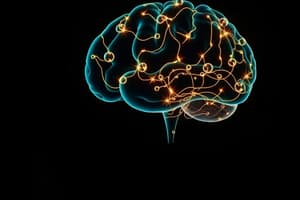Podcast
Questions and Answers
What does the primacy effect in long-term memory refer to?
What does the primacy effect in long-term memory refer to?
- Better recall for items at the beginning of a list (correct)
- Better recall for items in the middle of a list
- Better recall for items at the end of a list
- Better recall for items that were rehearsed less
Which of the following is a characteristic of explicit memory?
Which of the following is a characteristic of explicit memory?
- It is more durable than implicit memories
- It is often unconscious and automatic
- It requires less cognitive effort than implicit memory
- It involves recollection of facts and events (correct)
What is the primary focus of levels of processing theory?
What is the primary focus of levels of processing theory?
- The role of neural pathways in memory storage
- The impact of rehearsal on memory retention
- The difference between short-term and long-term memory
- The depth of processing affects how well information is remembered (correct)
According to the multiple trace theory, how are memories consolidated?
According to the multiple trace theory, how are memories consolidated?
Which of the following best explains the effect of interleaved practice on memory consolidation?
Which of the following best explains the effect of interleaved practice on memory consolidation?
What is a key characteristic of natural categories compared to the classical approach?
What is a key characteristic of natural categories compared to the classical approach?
Which of the following models of knowledge representation focuses on comparing features of objects?
Which of the following models of knowledge representation focuses on comparing features of objects?
What is one of the primary benefits of categorization mentioned in the content?
What is one of the primary benefits of categorization mentioned in the content?
In the classical approach, what is meant by the term 'defining features'?
In the classical approach, what is meant by the term 'defining features'?
What type of knowledge representation emphasizes stored examples of category members?
What type of knowledge representation emphasizes stored examples of category members?
Which system of memory storage is primarily responsible for storing images?
Which system of memory storage is primarily responsible for storing images?
What effect did dual coding have on memory retrieval according to the research?
What effect did dual coding have on memory retrieval according to the research?
Which of the following statements regarding abstract and concrete words is accurate based on the research?
Which of the following statements regarding abstract and concrete words is accurate based on the research?
According to the common coding theory criticism, what is suggested about memory representation?
According to the common coding theory criticism, what is suggested about memory representation?
What principle relates to the activation of closely related concepts in memory systems?
What principle relates to the activation of closely related concepts in memory systems?
What type of memory is characterized by retention due to past experiences without conscious awareness?
What type of memory is characterized by retention due to past experiences without conscious awareness?
Which effect describes how previous exposure to a stimulus improves responses to the same or similar stimuli?
Which effect describes how previous exposure to a stimulus improves responses to the same or similar stimuli?
What type of memory is specifically linked to personal experiences and tied to specific events in an individual's life?
What type of memory is specifically linked to personal experiences and tied to specific events in an individual's life?
Which type of amnesia results in the inability to recall memories formed before a traumatic incident?
Which type of amnesia results in the inability to recall memories formed before a traumatic incident?
Following a bilateral medial temporal lobe resection, what key ability did patient H.M. retain?
Following a bilateral medial temporal lobe resection, what key ability did patient H.M. retain?
What characteristic defines the dissociation effect observed in certain amnesic patients?
What characteristic defines the dissociation effect observed in certain amnesic patients?
What is the primary role of semantic memory?
What is the primary role of semantic memory?
Which scenario would most likely indicate anterograde amnesia?
Which scenario would most likely indicate anterograde amnesia?
What is the primary basis for categorization according to the prototype approach?
What is the primary basis for categorization according to the prototype approach?
Which level of categorization includes items like 'apple' and 'grape'?
Which level of categorization includes items like 'apple' and 'grape'?
What does the typicality effect refer to?
What does the typicality effect refer to?
Experts are more likely to use which level of terms to describe categories?
Experts are more likely to use which level of terms to describe categories?
In a study on family resemblance, what correlation was found between typicality ratings and shared attributes?
In a study on family resemblance, what correlation was found between typicality ratings and shared attributes?
What is a characteristic feature in the context of the prototype approach?
What is a characteristic feature in the context of the prototype approach?
Which of the following best describes the superordinate level of categorization?
Which of the following best describes the superordinate level of categorization?
Which research method was used by Kosslyn, Alpert, & Thompson in their categorization study?
Which research method was used by Kosslyn, Alpert, & Thompson in their categorization study?
Why do children learn basic level objects before superordinate or subordinate categories?
Why do children learn basic level objects before superordinate or subordinate categories?
What is one limitation of the prototype approach mentioned?
What is one limitation of the prototype approach mentioned?
Flashcards
Serial Position Effect
Serial Position Effect
Improved memory for items at the beginning (primacy) and end (recency) of a list compared to those in the middle.
Primacy effect
Primacy effect
Better recall of items at the beginning of a list due to rehearsal and transfer to long-term memory.
Recency effect
Recency effect
Better recall of items at the end of a list because they're still in short-term memory.
Short-term memory (STM)
Short-term memory (STM)
Signup and view all the flashcards
Long-term memory (LTM)
Long-term memory (LTM)
Signup and view all the flashcards
Nondeclarative memory
Nondeclarative memory
Signup and view all the flashcards
Repetition priming
Repetition priming
Signup and view all the flashcards
Episodic memory
Episodic memory
Signup and view all the flashcards
Semantic memory
Semantic memory
Signup and view all the flashcards
Procedural memory
Procedural memory
Signup and view all the flashcards
Amnesia
Amnesia
Signup and view all the flashcards
Patient H.M.
Patient H.M.
Signup and view all the flashcards
Retrograde amnesia
Retrograde amnesia
Signup and view all the flashcards
Anterograde amnesia
Anterograde amnesia
Signup and view all the flashcards
Category
Category
Signup and view all the flashcards
Concept
Concept
Signup and view all the flashcards
Classical Approach
Classical Approach
Signup and view all the flashcards
Natural Categories
Natural Categories
Signup and view all the flashcards
Prototype Approach
Prototype Approach
Signup and view all the flashcards
Feature Comparison Model
Feature Comparison Model
Signup and view all the flashcards
Semantic Network Models
Semantic Network Models
Signup and view all the flashcards
Connectionist Approach
Connectionist Approach
Signup and view all the flashcards
Schema Theory
Schema Theory
Signup and view all the flashcards
Dual Coding Theory
Dual Coding Theory
Signup and view all the flashcards
Study Notes
The Serial Position Effect
- The serial position effect describes how our memory for items in a list is affected by their position.
- Glanzer & Cunitz (1966) found that participants remembered items at the beginning (primacy) and end (recency) of a list better than items in the middle.
- The primacy effect occurs because items at the beginning of the list are rehearsed more, transferring them to long-term memory (LTS).
- The recency effect occurs because items at the end of the list are still in short-term memory (STS) at the time of recall. A mental math task (recall delay) only affects recency, showing its dependence on STS.
Problems with the Serial Position Effect
- It's difficult to distinguish between STS and LTS as they share similar characteristics:
- Both use acoustic, visual, and semantic coding
- Forgetting in both occurs due to interference
- The argument for parsimony suggests that memory is a continuum rather than separate systems.
- It is also unclear why we need separate memory systems.
Nondeclarative Memory (Implicit Memory)
- Nondeclarative memory refers to unconscious retention of past experiences.
- It is demonstrated in:
- Repetition priming effect: prior exposure to a stimulus makes subsequent responses to the same or similar stimuli faster.
- Word-fragment/stem completion tasks: Completing a word when given its first few letters is faster if you've seen the word before.
Theory of Memory Systems
- Endel Tulving (1972, 1985) proposed different types of memory within the long-term store:
- Episodic memory: stores personal experiences tied to a specific learning episode.
- Semantic memory: stores general knowledge, concepts, rules, and abstract ideas. It is not tied to any specific experience.
- Procedural memory: underlies motor and cognitive skills, such as riding a bike, playing chess, or doing math.
Evidence Supporting Tulving's Theory
- Certain amnesic patients may have damage to one memory system, but other systems remain intact, demonstrating a dissociation effect.
- Retrograde amnesia: inability to remember events before a traumatic event.
- Anterograde amnesia: inability to form new memories after a traumatic event.
Case Study: Patient H.M.
- Patient H.M. (Scoville & Milner, 1957; Corkin, 2013) had extensive medial temporal lobe (MTL) resection surgery to treat epilepsy.
- The surgery removed the hippocampus, parahippocampal gyrus, and amygdala, leading to profound amnesia.
- While H.M. exhibited normal IQ, short-term memory, and language abilities, he:
- Had temporal graded retrograde amnesia for events 11 years before surgery.
- Could not form new memories after surgery.
- Could form new procedural memories, despite lacking conscious awareness of the training episodes.
Conceptual Knowledge - Categorization
- A category is a class of objects sharing some relationship.
- A concept is the mental representation of a category.
- Generalization involves identifying shared features within a category.
- Discrimination involves recognizing the differences between categories.
Benefits of Categorization
- Reduces environmental complexity.
- Aids in object identification.
- Minimizes the need for constant learning.
- Enables us to make decisions about appropriate actions.
- Allows us to order and relate different classes of objects and events.
Classical Approach
- Based on lists of defining features, which are essential to an item's meaning.
- Each feature is individually necessary and collectively sufficient to define the category.
- Works well for logical categories like geometric shapes and prime numbers.
- Doesn't account for variability within categories, treating all members as equal.
Natural Categories
- Groups of objects or concepts that occur naturally in the world.
- Have fuzzy borders and overlapping memberships.
- Difficult to define with specific features.
Prototype Approach
- Based on prototypes: idealized, abstract representations that are most typical of a category.
- Concepts are organized hierarchically:
- Superordinate: broadest categories with few shared attributes (e.g., fruit, animals).
- Basic: most commonly used, with shared attributes and clear distinction from other basic categories (e.g., apple, dog).
- Subordinate: narrowest categories, less distinct (e.g., Golden Delicious apple, Poodle).
- Typicality effect: items differ in how well they represent a category.
- Family resemblance: members share at least one attribute with others in the category, contributing to typicality.
- Brain activity: Different brain regions are activated when processing different levels of categories.
Pros and Cons of Prototype Approach
- Accounts for loose groups of objects.
- Allows for variability within categories.
- Reduces information to a single idealized abstraction.
- Does not account for specific information about individual examples.
- Large number of potential features may be challenging to manage.
- Determining the weight of specific features remains unclear.
Feature Comparison Model
- Categorization based on comparing features of an item to stored features of category prototypes.
- More similar features to the category = more likely to be classified as belonging to that category.
Semantic Network Models
- Concepts represented as nodes in a network.
- Nodes are connected by links, representing relationships between concepts.
- Activation of a node spreads to connected nodes, influencing retrieval.
Connectionist Approach
- Concepts represented by patterns of activation across interconnected units.
- Learning involves adjusting connection strengths over time.
- Accounts for human learning and adaptability.
Schema Theory
- Stored knowledge structures that represent general knowledge about objects and situations.
- Different types of schemas:
- Scripts: knowledge structures for familiar events (e.g., going to a restaurant).
- Person schemas: knowledge about particular individuals.
- Role schemas: knowledge about social roles (e.g., teacher, doctor).
- Schemas can influence memory:
- Filling in gaps in memory with information from a schema.
- Overstating information consistent with a schema.
- Remembering information consistent with a schema even when it was not presented.
Benefits of Schemas
- Simplify and organize the world.
- Make sense of new information.
- Predict future events.
Dual Coding Theory
- Developed by Allan Paivio (1986, 2006) as a theory of cognition.
- Two independent, but interacting systems for storing information:
- Imagery system: stores images (right hemisphere processing).
- Verbal system: stores linguistic descriptions (left hemisphere processing).
- Processing can occur in one or both systems.
- Pictures: mainly image-based processing, but may be labelled (verbal processing).
- Concrete words: verbal processing, potentially also forming an image.
- Abstract words: only verbal processing occurs.
- Connections between concepts:
- Associative connections within the same system.
- Referential connections between the two systems.
- Activating one concept leads to activation of related concepts.
Support for Dual Coding Theory
- Paivio & Csapo (1969) showed that a faster presentation rate (5.3 items/s) limited participants to one code, while a slower rate (2 items/s) allowed for dual coding, leading to better recall.
- Kounios & Holcomb (1994) found that concrete words triggered more brain activity and activated both hemispheres equally, indicating dual coding, while abstract words activated the left hemisphere more, suggesting single coding.
Criticism of Dual Coding Theory
- Common coding theory argues that all memories are stored in the same way and there's no need for two different systems.
Studying That Suits You
Use AI to generate personalized quizzes and flashcards to suit your learning preferences.



